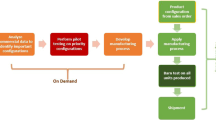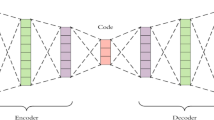Abstract
Being more competitive is routine in the aeronautical sector. Airline competitiveness is affected by such factors as time, price, reliability, availability, safety, technology, quality, and information management. To remain competitive, airlines must promptly identify and correct failures found in their fleet. This study aims at reducing the time spent on identifying and correcting such failures logged. Utilizing Text Mining techniques during the pre-processing phase, our study processes an extensive database of events from commercial regional jets. The result is a unique list of keywords that describes each reported failure. Later, an Artificial Neural Network (ANN) identifies and classifies failure patterns, yielding a respective disposition for a given failure pattern. Approximately five years of historical data was used to build and validate the present model. Results obtained were promising.






Similar content being viewed by others
Explore related subjects
Discover the latest articles, news and stories from top researchers in related subjects.References
Air Transport Association of America—ATA (2009). Spec2000: Chapter 11—Integrated Data Processing Materials Management. Washington, DC, USA.
Al-Jumaily, H., Martínez, P., Martínez-Fernández, J. L., & Van der Goot, E. (2011). A real time named entity recognition system for Arabic text mining. Language Resources and Evaluation, Published online first, 30 April 2011. doi:10.1007/s10579-011-9146-z.
ANAC—National Civil Aviation Agency (2009). Delay statistics in Brazil. http://www.anac.gov.br/. Accessed 01/10/2009.
Andrea, B., & Franco, T. (2011). Mining Bayesian networks out of ontologies. Journal of Intelligent Information Systems. Published online first, 13 June 2011. doi:10.1007/s10844-011-0165-4.
Balestrassi, P. P., Popova, E., Paiva, A. P., & Marangon Lima, J. W. (2009). Design of experiments on neural network’s training for nonlinear time series forecasting. Neurocomputing, 72(4–6), 1160–1178.
Batyrshin, I. Z., & Sheremetov, L. B. (2008). Perception-based approach to time series data mining. Applied Soft Computing, 8, 1211–1221.
Bineid, M., & Fielding, J. P. (2003). Development of a civil aircraft dispatch reliability prediction methodology. Aircraft Engineering and Aerospace Technology, 75, 588–594.
Bishop, C. M. (1995). Neural networks for pattern recognition (1a ed., Vol. 1, p. 477). New York: Oxford University Press.
Brants, T. (2000). TnT—a statistical part-of speech tagger. In: Proceedings of the Sixth Applied Natural Language Processing conference (ANLP 2000) (pp. 224–231). Seattle, WA.
BTS—US Bureau of Transportation—Statistics about delays. http://www.bts.gov/. Accessed 1 Aug 2009.
Chen, T., & Popova, E. (2002). Maintenance policies with two-dimensional warranty. Reliability Engineering and System Safety, 77, 61–69.
Chiang, D., Keh, H., Huang, H., & Chyr, D. (2008). The Chinese text categorization system with association rule and category priority. Expert Systems with Applications, 35, 102–110.
Dai, H. J., Chang, Y. C., Tsai, R. T. H., & Hsu, W. L. (2010). New challenges for biological text-mining in the next decade. Journal of Computer Science and Technology, 25(1), 169–179.
Dumais, S. (2004). Latent semantic analysis, ARIST. Review of Information Science and Technology, 38(4).
Farrero, J. M. C., Tarrés, L. G., & Losilla, C. B. (2002). Optimization of replacement stocks using a maintenance programme derived from reliability studies of production systems. Industrial Management and Data Systems, 102(4), 188–196.
Fernandez, O., Walmsley, R., & Petty, D. J. (2003). A decision support maintenance system—development and Implementation. International Journal of Quality and Reliability Management, 20(8), 965–979.
Hansson, J., Backlund, F., & Lycke, L. (2003). Managing commitment: Increasing the odds for successful implementation of TQM, TPM or RCM. International Journal of Quality and Reliability Management, 20(9), 993–1008.
Haykin, S. (1999). Neural networks—a comprehensive foundation (2nd ed., Vol. 1, p. 842). Ontario: Prentice Hall International.
Huang, J., Zhou, B., Wu, Q., Wang, X., & Jia, Y. (2011). Contextual correlation based thread detection in short text message streams. Journal of Intelligent Information Systems. Published online first, 24 May 2011. doi:10.1007/s10844-011-0162-7.
Hung, J. L., & Zhang, K. (2011). Examining mobile learning trends 2003–2008: A categorical meta-trend analysis using text mining techniques. Journal of Computing in Higher Education. Published online first, 10 March 2011. doi:10.1007/s12528-011-9044-9.
Jiménez, A., Molina-Solana, M., Berzal, F., & Fajardo, W. (2011). Mining transposed motifs in music. Journal of Intelligent Information Systems, 36(1), 99–115.
Knotts, R. M. H. (1999). Civil aircraft maintenance and support—fault diagnosis from a business perspective. Journal of Quality in Maintenance Engineering, 5(4), 335–347.
Kumar, U. D. (1999). New trends in aircraft reliability and maintenance measures. Journal of Quality in Maintenance Engineering, 5(4), 287–295.
Kurien, K. C., Sekhon, G. S., & Chawla, O. P. (1993). Analysis of aircraft reliability using Monte Carlo simulation. International Journal of Quality & Reliability Management, 10, 2.
LeCun, Y. (1993). Globally trained handwritten word recognizer using spatial representation, convolutional neural networks, and hidden Markov Models. In: 6th Neural Information Processing Systems (NIPS) (pp. 937–944). Denver, Colorado, USA.
Leitner, F., & Valencia, A. (2008). A text-mining perspective on the requirements for electronically annotated abstracts. Federation of European Biochemical Societes Letters, 582, 1178–1181.
Li, J., Wang, H. J., Zhang, Z., & Zhao, J. L. (2010). A policy-based process mining framework: Mining business policy texts for discovering process models. Information Systems and E-Business Management, 8(2), 169–188.
Dey, L., & Haque, S. M. (2009). Opinion mining from noisy text data discovering knowledge. International Journal on Document Analysis and Recognition, 12(3), 205–226.
Losiewicz, P., Oard, D. W., & Kostoff, R. N. (2000). Textual data mining to support science and technology management. Journal of Intelligent Information Systems, 15(2), 99–119.
Luxhøj, J. T. (1999). Trending of equipment inoperability for commercial aircraft. Reliability Engineering and System Safety, 64(3), 365–381.
Macskassy, S. A. (2011). Contextual linking behavior of bloggers: Leveraging text mining to enable topic-based analysis. Social Network Analysis and Mining. Published online first, 25 May 2011. doi:10.1007/s13278-011-0026-8.
Madu, C. N. (2000). Competing through maintenance strategies. International Journal of Quality & Reliability Management, 17(9), 937–948.
Magerman, T., Looy, B. V., & Song, X. (2010). Exploring the feasibility and accuracy of latent semantic analysis based text mining techniques to detect similarity between patent documents and scientific publications. Scientometrics, 82(2), 289–306.
Manco, G., Masciari, E., & Tagarelli, A. (2008). Mining categories for emails via clustering and pattern discovery. Journal of Intelligent Information Systems, 30(2), 153–181.
Manning, C. D., & Schütze, H. (2002). Foundations of statistical natural language processing (5th printing). Cambridge: MIT.
Orengo, V., & Huyck, C. (2001). A stemming algorithm for the portuguese language. In: Eighth symposium on string processing and information retrieval (p. 186). Spire.
Prabowo, R., & Thelwall, M. (2006). A comparison of feature selection methods for an evolving RSS feed corpus. Journal of Information processing and management, 42, 1491–1512.
Prado, H. A., & Ferneda, E. (2008). Emerging technologies of text mining—techniques and applications (1st ed., Vol. 1, p. 358). Hershey: Information Science Reference—IGI Global.
Punuru, J., & Chen, J. (2011). Learning non-taxonomical semantic relations from domain texts. Journal of Intelligent Information Systems. Published online first, 20 January 2011. doi:10.1007/s10844-011-0149-4.
Rajpathak, D., Chougule, R., & Bandyopadhyay, P. (2011). A domain-specific decision support system for knowledge discovery using association and text mining. Knowledge and Information Systems, Published online first, 18 May 2011. doi:10.1007/s10115-011-0409-1.
Sarac, A. (2000). Daily operational aircraft maintenance routing problem. PhD Dissertation, University of Buffalo at New York, NY.
Sekhon, G. S., Rajpal, P. S., & Shishodia, K. S. (2006). An artificial neural network for modeling reliability, availability, and maintainability of a repairable system. Reliability Engineering and System Safety, 91(7), 809–819.
Shamsinejadbabki, P., & Saraee, M. (2011). A new unsupervised feature selection method for text clustering based on genetic algorithms. Journal of Intelligent Information Systems. Published online first, 27 July 2011. doi:10.1007/s10844-011-0172-5.
Shankar, G., & Sahani, V. (2003). Reliability analysis of a maintenance network with repair and preventive maintenance. International Journal of Quality & Reliability Management, 20(2), 268–280.
Shimazaki, K., & Kushida, T. (2010). A preliminary approach to creating an overview of lactoferrin multi-functionality utilizing a text mining method. BioMetals, 23(3), 453–463.
Söderholm, P. (2005). A system view of the No Fault Found (NFF) phenomenon. Reliability Engineering and System Safety, 92, 1–14.
Song, Y. L., & Chen, S. S. (2009). Text mining biomedical literature for constructing gene regulatory networks Interdisciplinary Sciences. Computational Life Sciences, 1(3), 179–186.
Tan, S. (2008). An improved centroid classifier for text categorization. Expert Systems with Applications, 35, 279–285.
Tremblay, M. C., Berndt, D. J., Luther, S. L., Foulis, P. R., & French, D. D. (2009). Identifying fall-related injuries: Text mining the electronic medical record. Information Technology and Management, 10(4), 253–265.
Tsay, R. (2005). Analysis of financial time series (2nd ed.). Wiley-Interscience.
Wang, W. M., Cheung, C. F., Lee, W. B., & Kwok, S. K. (2008). Mining knowledge from natural language texts using fuzzy associated concept mapping. Information Processing and Management, 44, 1707–1719.
Yang, Y., & Pedersen, J. (1997). A comparative study on feature selection in text categorization. In: Proceedings of ICML-97, 14th international conference on machine learning (pp. 412–420).
Yang, S., Wu, X., Deng, Z., Zhang, M., & Yang, D. (2002). Relative term-frequency based feature selection for text categorization. In: Proceedings of the first international conference on machine learning and cybernetics (pp. 1432–1436). Beijing: IEEE.
Acknowledgement
The authors would like to thank CNPq and FAPEMIG for the support they gave this work.
Author information
Authors and Affiliations
Corresponding author
Rights and permissions
About this article
Cite this article
Rodrigues, R.S., Balestrassi, P.P., Paiva, A.P. et al. Aircraft interior failure pattern recognition utilizing text mining and neural networks. J Intell Inf Syst 38, 741–766 (2012). https://doi.org/10.1007/s10844-011-0176-1
Received:
Revised:
Accepted:
Published:
Issue Date:
DOI: https://doi.org/10.1007/s10844-011-0176-1




